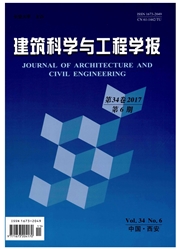

 中文摘要:
中文摘要:
采用自制火灾试验炉对整体钢框架中4个钢筋混凝土连续板格和2个组合钢梁的热振动特性进行了试验研究。采集了构件受火时的加速度信号并尝试利用希尔伯特变换提取主频率,并对加速度信号进行时域分析和频域分析。时域分析结果表明:加速度信号强度与边界约束和裂缝开展密切相关,约束越强,振动信号越弱;主裂缝开展导致板格加速度信号发生突变,而组合钢梁的信号突变则受到应力重分布和主裂缝开展的影响;升温阶段加速度曲线可分为3个阶段,前期和后期振动幅值很小,中期振动幅值较大且伴随较多的信号突变。频域分析结果表明:受火时主频率变化显著并呈现下降的趋势,但频率改变只能反映裂缝开展程度,不能确定裂缝位置,且频率变化近似与挠度的变化过程相对应;通过振动特征分析可以有效监测楼板的变形、裂缝开展等受火行为。
 英文摘要:
英文摘要:
Thermal vibration characteristics of four continuous reinforced concrete panels and two composite beams in a whole steel-framed structure were tested by using the self-made fire furnace.The acceleration signals of the building components during the fire were collected and Hilbert transform(HT)was adopted to extract instantaneous principal frequencies.Time-domain analysis and frequency-domain analysis of acceleration signals were performed.Time-domain analysis shows that acceleration signal intensity has important relationship with boundary constraints and crack propagation.When the constraints are stronger,the signal intensity is weaker.Moreover,main crack propagation leads to mutations of acceleration signals of heated panels,but for composite beams,stress redistribution and main crack propagation stimulate mutations of acceleration signals.During the heat-up stage,acceleration curves can be dividedinto three stages.Acceleration signals are relatively low during the early and late stages but strong during the medium stage with more signal mutations are detected.Frequency-domain analysis shows that principal frequencies change dramatically and present a downward trend during the heat-up stage,but the changes only reflect the level of crack propagation and cannot identify damage locations.In addition,the frequency changes correspond approximately to deflection changes in sequence.Therefore through analysis of vibration characteristics,the fire behavior including deformation and cracks can be monitored.
 同期刊论文项目
同期刊论文项目
 同项目期刊论文
同项目期刊论文
 Fire behaviour of continuous reinforced concrete slabs in a full-scale multi-storey steel-framed bui
Fire behaviour of continuous reinforced concrete slabs in a full-scale multi-storey steel-framed bui 期刊信息
期刊信息
